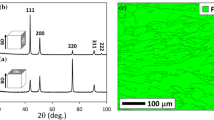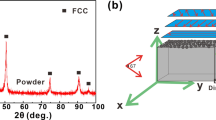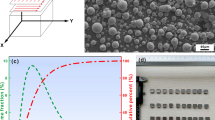Abstract
The industrial application of novel high-entropy alloys (HEAs), consisting of five or more principal elements having composition between 5 and 35 at.%, requires suitable manufacturing processes. The conventional fabrication routes for HEAs are casting and powder metallurgy. The casting route often leads to elemental segregation, whereas the powder metallurgy consumes more resources and can lead to metastable products. Additive manufacturing or 3D-printing has emerged to be effective in curbing some drawbacks of conventional manufacturing routes for HEAs [1]. The CrMnFeCoNi HEA (also referred to as Cantor alloy) has been reported to exhibit an excellent combination of strength and ductility [2]. Lately, the CrMnFeCoNi HEA fabricated via 3D-printing has been observed to have a chemically more homogeneous single face-centered cubic (FCC) solid solution structure [3, 4]. However, the selective laser-melted CrMnFeCoNi HEA has a hierarchical microstructure composed of large columnar grains, melt pools, and small cells [4]. While several researchers have studied the as-fabricated microstructures of the 3D-printed Cantor alloy, relatively scarce information is available on its deformed microstructure. Thus, this study was aimed to investigate the tensile deformation microstructure of the selective laser-melted CrMnFeCoNi HEA through electron backscatter diffraction (EBSD).
Access provided by Autonomous University of Puebla. Download conference paper PDF
Similar content being viewed by others
Keywords
1 Introduction
The industrial application of novel high-entropy alloys (HEAs), consisting of five or more principal elements having composition between 5 and 35 at.%, requires suitable manufacturing processes. The conventional fabrication routes for HEAs are casting and powder metallurgy. The casting route often leads to elemental segregation, whereas the powder metallurgy consumes more resources and can lead to metastable products. Additive manufacturing or 3D-printing has emerged to be effective in curbing some drawbacks of conventional manufacturing routes for HEAs [1]. The CrMnFeCoNi HEA (also referred to as Cantor alloy) has been reported to exhibit an excellent combination of strength and ductility [2]. Lately, the CrMnFeCoNi HEA fabricated via 3D-printing has been observed to have a chemically more homogeneous single face-centered cubic (FCC) solid solution structure [3, 4]. However, the selective laser-melted CrMnFeCoNi HEA has a hierarchical microstructure composed of large columnar grains, melt pools, and small cells [4]. While several researchers have studied the as-fabricated microstructures of the 3D-printed Cantor alloy, relatively scarce information is available on its deformed microstructure. Thus, this study was aimed to investigate the tensile deformation microstructure of the selective laser-melted CrMnFeCoNi HEA through electron backscatter diffraction (EBSD).
2 Experimental Methods
Laser beam powder bed fusion (PBF-LB) was performed using prealloyed equiatomic CrMnFeCoNi HEA powders at a power of 220 W and at a scanning speed, scanning distance, and layer thickness of 900 mm/s, 100 μm, and 30 μm, respectively. The bottom plate heating temperature was set to be 150 °C. The tensile deformation was performed using Instron 8801 servo-hydraulic testing system at room temperature and at a strain rate of 10−4 s−1 until failure. For electron backscatter diffraction (EBSD), the specimen was first mechanically polished and then electropolished using HClO4:C2H5OH:: 1:10 at 25 V for 10 s. The electropolished specimen was ultrasonically cleaned in ethanol before EBSD.
3 Results and Discussion
Figure 1a shows the EBSD IPF map of the deformed specimen. The directions LD, ND, and TD stand for loading/longitudinal direction, normal direction, and transverse/building direction, respectively. The large grain size of over 200 μm is seen due to the columnar growth of grains during the PBF-LB. The large grains are observed to undergo more deformation and develop misoriented regions. These subgranular regions are mildly misoriented with respect to the surrounding crystal. This is evident from the local changes in the color of the grains in the IPF map, as shown in Fig. 1a, where the dashed boxes enclose the regions with local changes in the grain orientation.
Figure 1b shows the band contrast map of the site corresponding to Fig. 1a. The CrMnFeCoNi HEA generally exists as a face-centered cubic (FCC) solid solution [5]. The multiple “crisscross” lines seen in Fig. 1b are at an angle of ~70.5°, which confirms that these lines are slip traces since the angle between any two closed-packed {111} slip planes in the FCC structure is always 70.53°. The intersecting slip traces in Fig. 1b prove that more than one slip system is activated in the same grain during the tensile deformation. The activation of multiple slip systems thereby allows the grains to accommodate more plastic strain, thus leading to significant ductility of the 3D-printed CrMnFeCoNi HEA alloy.
4 Conclusions
The tensile deformation microstructures of a CrMnFeCoNi HEA or Cantor alloy fabricated by laser beam powder bed fusion were examined in this study. It was observed that the large columnar grains in the 3D-printed HEA deformed to develop subgranular misoriented regions, which showed color changes in the EBSD IPF maps. The slip traces emerged on the EBSD band contrast maps as the grains underwent plastic deformation. The multiple intersecting slip traces at an angle of ~70.5° represented the activation of multiple slip systems, which reflected a higher extent of accommodation of plastic strain in the 3D-printed CrMnFeCoNi HEA.
References
Melia MA, Carroll JD, Whetten SR, Esmaeely SN, Locke J, White E et al (2019) Mechanical and corrosion properties of additively manufactured CoCrFeMnNi high-entropy alloy. Addit Manuf 29:100833. https://doi.org/10.1016/j.addma.2019.100833
Sun SJ, Tian YZ, Lin HR, Dong XG, Wang YH, Zhang ZJ et al (2017) Enhanced strength and ductility of bulk CoCrFeMnNi high-entropy alloy having fully recrystallized ultrafine-grained structure. Mater Des 133:122–127. https://doi.org/10.1016/j.matdes.2017.07.054
Kim YK, Yang S, Lee KA (2020) Compressive creep behavior of selective laser-melted CoCrFeMnNi high-entropy alloy strengthened by in-situ formation of nano-oxides. Addit Manuf 36:101543. https://doi.org/10.1016/j.addma.2020.101543
Zhu ZG, Nguyen QB, Ng FL, An XH, Liao XZ, Liaw PK et al (2018) Hierarchical microstructure and strengthening mechanisms of a CoCrFeNiMn high-entropy alloy additively manufactured by selective laser melting. Scr Mater 154:20–24. https://doi.org/10.1016/j.scriptamat.2018.05.015
Eleti RR, Bhattacharjee T, Zhao L, Bhattacharjee PP, Tsuji N (2018) Hot deformation behavior of CoCrFeMnNi FCC high-entropy alloy. Mater Chem Phys 210:176–186. https://doi.org/10.1016/j.matchemphys.2017.06.062
Acknowledgments
The authors would like to thank the Natural Sciences and Engineering Research Council of Canada (NSERC), Alberta Innovates, and the National Natural Science Foundation of China (NSFC) (Grant Nos 51871168, 52271012) for the financial support. The authors would also like to thank Messrs. Q. Li, A. Machin, and J. Schwartz for their assistance and easy access to the laboratory facilities of Toronto Metropolitan University and their assistance in the experiments.
Author information
Authors and Affiliations
Corresponding author
Editor information
Editors and Affiliations
Rights and permissions
Copyright information
© 2023 The Author(s), under exclusive license to Springer Nature Switzerland AG
About this paper
Cite this paper
Bajaj, D., Chen, Z., Qu, S.J., Feng, A.H., Li, D.Y., Chen, D.L. (2023). Tensile Deformation Microstructure of 3D-Printed CrMnFeCoNi Alloy. In: Proceedings of the 62nd Conference of Metallurgists, COM 2023. COM 2023. Springer, Cham. https://doi.org/10.1007/978-3-031-38141-6_49
Download citation
DOI: https://doi.org/10.1007/978-3-031-38141-6_49
Published:
Publisher Name: Springer, Cham
Print ISBN: 978-3-031-38140-9
Online ISBN: 978-3-031-38141-6
eBook Packages: Chemistry and Materials ScienceChemistry and Material Science (R0)





